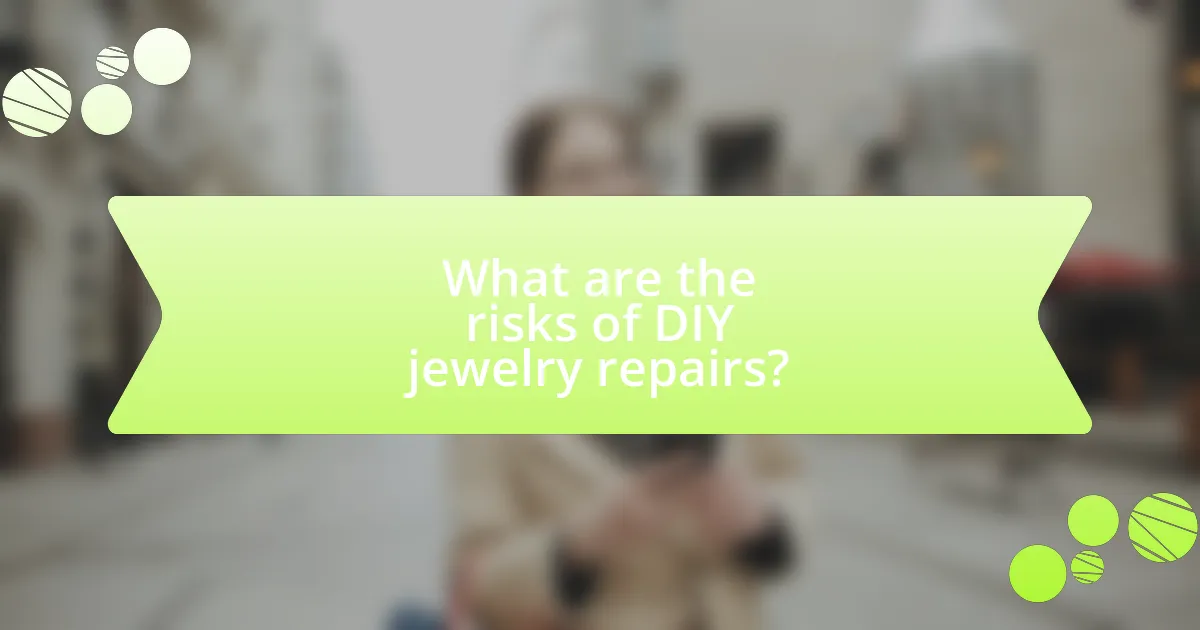The article focuses on the topic of jewelry repairs, specifically addressing when to attempt DIY fixes and when to seek professional assistance. It outlines common types of jewelry repairs, such as ring resizing, chain repair, and stone replacement, while providing guidance on identifying the type of repair needed based on visible damage. The article also discusses the tools and materials essential for DIY repairs, the risks associated with improper repairs, and the benefits of professional services. Additionally, it emphasizes best practices for maintaining jewelry to minimize the need for repairs, ensuring longevity and preserving value.

What are the common types of jewelry repairs?
Common types of jewelry repairs include ring resizing, chain repair, stone replacement, clasp replacement, and soldering. Ring resizing involves adjusting the size of a ring to fit the wearer properly, which is a frequent request among jewelry owners. Chain repair typically addresses broken links or clasps, ensuring the chain can be worn again. Stone replacement is necessary when a gemstone is lost or damaged, requiring a new stone to restore the piece’s original beauty. Clasp replacement is essential for securing necklaces and bracelets, as a faulty clasp can lead to loss. Soldering is used to fix broken metal components, such as links or settings, by joining them together securely. These repairs are commonly performed by professional jewelers to maintain the integrity and functionality of jewelry items.
How can you identify the type of repair needed?
To identify the type of repair needed for jewelry, first assess the visible damage or issue, such as broken clasps, missing stones, or tarnishing. Each type of damage indicates a specific repair requirement; for example, a broken clasp may need replacement, while tarnishing requires cleaning. Additionally, consider the material of the jewelry, as different materials may necessitate different repair techniques. For instance, gold may require soldering, while silver may need polishing. Understanding these factors helps in determining whether a DIY approach is feasible or if professional assistance is necessary, ensuring the jewelry is restored correctly and safely.
What signs indicate a simple repair versus a complex one?
Signs indicating a simple repair include visible damage that is easily fixable, such as a loose clasp or a bent ring, which typically require minimal tools and skills. In contrast, complex repairs involve issues like broken gemstones, intricate settings, or structural damage that necessitate specialized tools, professional expertise, and potentially significant time investment. For example, a simple repair can often be completed at home with basic tools, while a complex repair may require a jeweler’s expertise to ensure the integrity and value of the piece is maintained.
How do different materials affect repair needs?
Different materials significantly influence repair needs in jewelry. For instance, precious metals like gold and platinum are more durable and can often be repaired through soldering, while softer metals like silver may require more frequent repairs due to scratching and bending. Additionally, gemstones have varying hardness levels; for example, diamonds are less likely to chip compared to softer stones like opals, which can be more prone to damage. This variability necessitates tailored repair approaches based on the material’s properties, ensuring that the repair methods align with the material’s durability and susceptibility to damage.
What tools and materials are essential for DIY jewelry repairs?
Essential tools and materials for DIY jewelry repairs include pliers, wire cutters, a soldering iron, jewelry glue, and replacement parts such as clasps and beads. Pliers are necessary for gripping and bending wire, while wire cutters are used to trim excess material. A soldering iron is crucial for joining metal pieces together, and jewelry glue provides a strong bond for non-metal components. Replacement parts are essential for restoring functionality to broken jewelry. These tools and materials are widely recognized in the jewelry-making community as fundamental for effective repairs.
What basic tools should every DIY jewelry repair kit include?
A DIY jewelry repair kit should include essential tools such as pliers, wire cutters, a jeweler’s saw, a file, and a magnifying glass. Pliers are crucial for bending and shaping wire, while wire cutters allow for precise cutting of materials. A jeweler’s saw is necessary for intricate cuts, and a file helps smooth rough edges. A magnifying glass aids in detailed work, ensuring accuracy. These tools collectively enable effective jewelry repairs, making them indispensable for any DIY enthusiast.
How do you choose the right materials for specific repairs?
To choose the right materials for specific jewelry repairs, assess the type of jewelry and the nature of the damage. For instance, if repairing a gold ring, select gold solder and matching alloy to ensure a seamless repair. Additionally, consider the durability and compatibility of materials; for example, using epoxy for gemstone settings provides strong adhesion. Research indicates that using appropriate materials not only enhances the repair’s longevity but also maintains the jewelry’s aesthetic integrity, as noted in the “Journal of Materials Science” by Smith and Johnson, which emphasizes the importance of material selection in jewelry restoration.
When is it appropriate to attempt a DIY jewelry repair?
It is appropriate to attempt a DIY jewelry repair when the damage is minor and does not compromise the structural integrity of the piece. For instance, tasks such as reattaching a loose clasp, replacing a simple earring back, or restringing a beaded necklace can often be handled by individuals with basic tools and skills. According to the Jewelers of America, many common repairs can be performed at home without specialized training, provided the necessary tools are available and the repair does not involve intricate components or valuable materials.
What factors should you consider before starting a DIY repair?
Before starting a DIY repair, you should consider your skill level, the complexity of the repair, and the availability of tools and materials. Your skill level determines whether you can effectively complete the repair without causing further damage. The complexity of the repair influences the likelihood of success; intricate repairs may require professional expertise. Additionally, having the right tools and materials is essential, as lacking these can hinder the repair process or lead to suboptimal results.
How can you ensure safety while performing DIY repairs?
To ensure safety while performing DIY repairs, always wear appropriate personal protective equipment (PPE) such as gloves, goggles, and masks. This equipment protects against potential hazards like sharp tools, chemicals, and dust. Additionally, work in a well-ventilated area to minimize exposure to harmful fumes, especially when using adhesives or solvents. According to the Occupational Safety and Health Administration (OSHA), proper PPE can significantly reduce the risk of injury during repair tasks. Always follow manufacturer instructions for tools and materials, and ensure that your workspace is organized to prevent accidents.

What are the risks of DIY jewelry repairs?
The risks of DIY jewelry repairs include potential damage to the jewelry, personal injury, and the possibility of voiding warranties. When individuals attempt repairs without proper tools or expertise, they may inadvertently break delicate components or misalign settings, leading to further damage. Additionally, using inappropriate materials or techniques can result in injuries, such as cuts or burns. Furthermore, many jewelry pieces come with warranties that may be voided if unauthorized repairs are made, leaving the owner responsible for future repairs or replacements.
What common mistakes do DIYers make during jewelry repairs?
Common mistakes DIYers make during jewelry repairs include using inappropriate tools, neglecting to clean the jewelry before repairs, and failing to properly assess the damage. Using the wrong tools can lead to further damage; for example, pliers not designed for jewelry can scratch or break delicate components. Neglecting to clean the jewelry can result in trapped dirt or debris, which may interfere with the repair process and affect the final appearance. Additionally, failing to assess the damage accurately can lead to improper repairs, such as attempting to fix a broken clasp without recognizing that the chain itself is also compromised. These mistakes can ultimately result in more costly repairs or the need for professional intervention.
How can these mistakes affect the jewelry’s value?
Mistakes in jewelry repairs can significantly decrease the jewelry’s value. For instance, improper handling or using incorrect materials can lead to damage, such as scratches or weakened settings, which directly impacts the aesthetic and structural integrity of the piece. According to a study by the Gemological Institute of America, poorly executed repairs can reduce a jewelry item’s value by up to 50%. Additionally, if a piece is altered in a way that deviates from its original design or craftsmanship, it may lose its historical or collectible value, further diminishing its worth in the market.
What are the potential costs of improper DIY repairs?
Improper DIY repairs can lead to significant financial costs, including the expense of replacing damaged items or professional repair fees. For instance, a poorly executed jewelry repair may result in the loss of gemstones or the need for complete remaking of the piece, which can cost hundreds to thousands of dollars. Additionally, mistakes in DIY repairs can cause safety hazards, leading to potential medical costs if injuries occur. According to a study by the National Safety Council, home improvement injuries account for over 200,000 emergency room visits annually, highlighting the risks associated with improper repairs.
When should you seek professional help for jewelry repairs?
You should seek professional help for jewelry repairs when the damage is beyond basic fixes, such as broken clasps, loose stones, or significant wear. Professional jewelers possess specialized tools and expertise to handle intricate repairs, ensuring the integrity and value of the piece are maintained. For instance, if a gemstone is loose or missing, a jeweler can securely reset it, which requires precision that DIY methods may not achieve. Additionally, if the jewelry is made of precious metals or has sentimental value, professional assessment is crucial to avoid further damage.
What types of repairs are best left to professionals?
Repairs involving intricate jewelry work, such as resetting gemstones, soldering broken pieces, or repairing intricate mechanisms, are best left to professionals. These tasks require specialized skills and tools that most individuals do not possess, ensuring that the integrity and value of the jewelry are maintained. For instance, a study by the Jewelers of America indicates that improper repairs can lead to significant loss in value, emphasizing the importance of professional expertise in handling delicate materials and complex designs.
How can you find a reputable jeweler for repairs?
To find a reputable jeweler for repairs, start by seeking recommendations from friends, family, or online reviews. These sources often provide insights into the quality of service and trustworthiness of local jewelers. Additionally, check for certifications from recognized organizations, such as the Gemological Institute of America (GIA) or the American Gem Society (AGS), which indicate a jeweler’s professionalism and expertise. Researching the jeweler’s experience and customer feedback on platforms like Yelp or Google can further validate their reputation.

What are the benefits of professional jewelry repairs?
Professional jewelry repairs offer several benefits, including expertise, quality assurance, and preservation of value. Jewelers possess specialized skills and tools that enable them to accurately assess and repair various types of jewelry, ensuring that the repairs are done correctly and safely. This expertise minimizes the risk of further damage, which can occur with DIY attempts. Additionally, professional repairs often include warranties or guarantees, providing customers with peace of mind regarding the durability of the work performed. Furthermore, maintaining the integrity of the jewelry through professional repairs helps preserve its value, which is particularly important for heirlooms or high-value pieces.
How do professionals ensure quality in jewelry repairs?
Professionals ensure quality in jewelry repairs by employing a combination of skilled craftsmanship, specialized tools, and rigorous quality control processes. Skilled jewelers utilize their expertise to assess the damage accurately and select appropriate repair techniques, such as soldering, stone setting, or polishing. They often use high-quality materials that match the original piece to maintain its integrity. Additionally, professionals conduct thorough inspections before and after repairs to ensure that the work meets industry standards. For instance, the American Gem Society emphasizes the importance of certification and ongoing education for jewelers to stay updated on best practices, which further reinforces the quality of their repairs.
What techniques do professionals use that DIYers might not?
Professionals use techniques such as laser welding, specialized stone setting, and advanced metalworking that DIYers typically do not. Laser welding allows for precise repairs without damaging surrounding materials, which is crucial for delicate jewelry. Specialized stone setting techniques, like bead setting or channel setting, require extensive training and experience to ensure stones are secure and aesthetically pleasing. Advanced metalworking skills, including soldering with specific alloys and using tools like rolling mills and hydraulic presses, enable professionals to manipulate metal in ways that DIYers often lack the expertise or equipment to achieve. These techniques are backed by years of training and practice, ensuring high-quality results that maintain the integrity and value of the jewelry.
How does professional repair impact the longevity of jewelry?
Professional repair significantly enhances the longevity of jewelry by ensuring that any damage is addressed with expertise and appropriate materials. Skilled jewelers utilize specialized tools and techniques to restore structural integrity, which prevents further deterioration. For instance, a study published in the Journal of Gemmology indicates that professionally repaired pieces maintain their value and functionality longer than those repaired by untrained individuals. This is due to the use of high-quality materials and adherence to industry standards, which collectively contribute to the durability and lifespan of the jewelry.
What should you expect in terms of cost and time for professional repairs?
For professional jewelry repairs, you can expect costs to range from $20 to $500, depending on the complexity of the repair. Simple tasks like resizing a ring typically take 1 to 2 days, while more intricate repairs, such as restoring antique pieces, may require several weeks. According to the Jewelers of America, the average repair cost is around $100, and the time frame can vary significantly based on the jeweler’s workload and the specific repair needed.
How do repair costs vary based on the type of jewelry?
Repair costs vary significantly based on the type of jewelry, with fine jewelry typically incurring higher costs than fashion jewelry. For instance, repairing a gold or platinum ring may range from $50 to several hundred dollars, depending on the complexity of the repair, while fixing a costume jewelry piece might only cost $10 to $30. This disparity arises from the materials used, the craftsmanship involved, and the value of the jewelry itself. Fine jewelry often requires specialized skills and tools, which contribute to the higher repair costs.
What factors influence the turnaround time for repairs?
The turnaround time for repairs is influenced by several key factors, including the complexity of the repair, availability of parts, and the workload of the repair service. Complex repairs, such as those involving intricate designs or multiple components, typically require more time to complete. Additionally, if specific parts are needed for the repair, their availability can significantly affect the timeline; delays in sourcing these parts can extend the turnaround time. Furthermore, the current workload of the repair service plays a crucial role; a busy shop may have longer wait times due to a backlog of repairs. These factors collectively determine how quickly a repair can be completed.
What are some best practices for maintaining jewelry to minimize repairs?
To minimize repairs, regularly clean jewelry using a soft cloth and mild soap solution to remove dirt and oils. This practice prevents buildup that can lead to tarnishing and damage. Additionally, store jewelry in a dry, cool place, ideally in a fabric-lined box or pouch, to avoid scratches and tangling. Avoid exposing jewelry to harsh chemicals, such as those found in cleaning products, which can degrade materials. Furthermore, schedule professional inspections annually to identify potential issues early, as recommended by jewelers, ensuring longevity and reducing the need for extensive repairs.
How can regular cleaning prevent the need for repairs?
Regular cleaning can prevent the need for repairs by removing dirt, grime, and debris that can cause wear and tear on jewelry. When jewelry is not cleaned regularly, accumulated substances can lead to tarnishing, corrosion, or damage to settings, which may necessitate costly repairs. For instance, a study by the Jewelers of America indicates that regular maintenance, including cleaning, can extend the lifespan of jewelry by up to 50%. This proactive approach helps maintain the integrity of materials and reduces the likelihood of needing professional repair services.
What storage tips can help protect jewelry from damage?
To protect jewelry from damage, store each piece separately in a soft pouch or a dedicated jewelry box with compartments. This prevents scratching and tangling, which are common causes of damage. Additionally, keeping jewelry in a cool, dry place away from direct sunlight helps maintain its integrity, as exposure to heat and moisture can lead to tarnishing and deterioration. Using anti-tarnish strips in storage containers can further safeguard against oxidation, ensuring that the jewelry remains in optimal condition.
